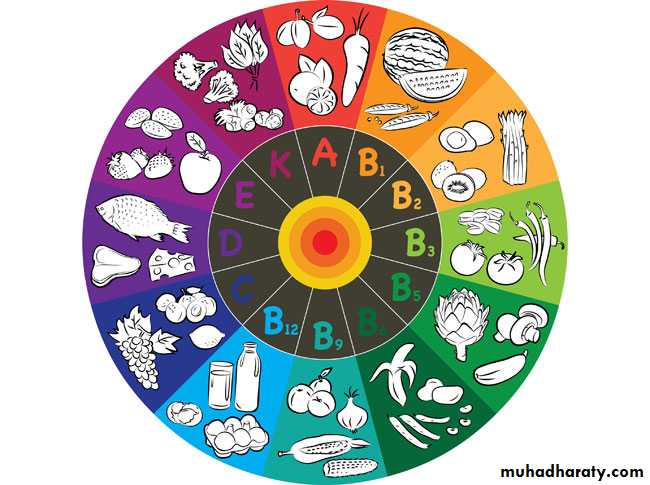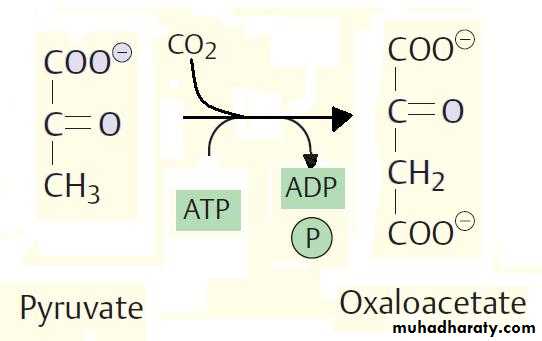Vitamins
A vitamin is an organic compound and a vital nutrient that an organism requires in limited amounts. An organic chemical compound is called a vitamin when the organism cannot synthesize the compound in sufficient quantities, and must be obtained through the diet; thus, the term "vitamin" is conditional upon the circumstances and the particular organism, although it requires them in small amounts for metabolismMost vitamins are precursors of coenzymes; in some cases, they are also precursors of hormones or act as antioxidants. Vitamin requirements vary from species to species and are influenced by age, sex, and physiological conditions such as pregnancy, breast-feeding, physical exercises, and nutrition.
The vitamins are divided into two groups: water-soluble vitamins and fat-soluble vitamins.
1- Water- soluble vitamins:
This group of vitamins consist of vitamin B group and vitamin CVitamin B :
The B vitamins are
B1 (thiamine)
B2 (riboflavin)
B3 (niacin)
B5 (pantothenic acid)
B6 (pyridoxine)
B9 (biotin)
B12(cobalamin)
HYPERLINK "http://www.nlm.nih.gov/medlineplus/folicacid.html" Folic acid
These vitamins help the process our body uses to get or make energy from the food . They also help form red blood cells. B vitamins exist in proteins such as fish, poultry, meat, eggs, and dairy products. Leafy green vegetables, beans, peas and many cereals have some B vitamins.
1-Thiamine . Vit B1:
Vitamin B1 (thiamine) contains two heterocyclic rings—a pyrimidine ring and a thiazole ring which are joined by a methylene group. The active form of vitamin B1 is thiamine
diphosphate (TPP), which contributes as a coenzyme to the transfer of hydroxyl-alkyl residues (active aldehyde groups). The most important reactions of this type are oxidative
decarboxylation of 2-oxoacids and the transketolase reaction in the pentose phosphate pathway.Thiamin is a coenzyme for many cellular enzymes like pyruvate dehydrogenase, α-ketoglutarate dehydrogenase, transketolase,and others. Consequently, this coenzyme is needed in biochemical pathways like glycolytic pathway , TCA cycle, hexose monophosphate shunt and the metabolism of valine, isoleucine and leucine.
Vitamin B1 deficiency leads to beriberi, a disease with symptoms that include neurological disturbances, cardiac insufficiency, and muscular atrophy. Most common causes of vit B1 deficiency are alcoholism (alcohol interferes with the absorption) and psychosis.
HOME WORK-------------------------------------------------------------------------
Q1- what is the active form of vit B1? Explain the coenzyme role of thiamine.
Q2-The requirement of thiamine increase with increase the load of carbohydrate in the diet --- why ?
Q3-What is the causes of lactic acidosis in thiamine deficiency?
Q4-Explain how a deficiency of thiamine in the diet will cause serious effects on health.
2- Riboflavin. Vit B2:
Vitamin B2 Riboflavin (from the Latin flavus, yellow) serves in the metabolism as a component of the redox coenzymes flavin mononucleotide (FMN) and flavin adenine dinucleotide As prosthetic groups, FMN and FAD are cofactors for various oxidoreductases .Its deficiency is associated with corneal neovascularization, cheilosis and stomatitis (cracking or scaling of lip borders and corners of the mouth) , magenta -colored tongue.
Electron redox reactions of riboflavin
3- Niacin. Vit B3:Nicotinate and nicotinamide, together referred to as “niacin,” are required for biosynthesis of the coenzymes nicotinamide adenine dinucleotide (NAD+) and nicotinamide adenine dinucleotide phosphate (NADP+). These both serve in energy and nutrient metabolism as carriers of hydride ions . The animal organism is able to convert tryptophan into nicotinate, but only with a poor yield. Vitamin deficiency therefore only occurs when nicotinate, nicotinamide, and tryptophan are all simultaneously are lacking in the diet. It manifests in the form of (pellagra). Pellagra is the "disease of the four D's"
Diarrhea.
Dermatitis: inflammation of the skin .
Dementia: Mental disorientation, delusions and depression.
Death.
4- pantothenic acid. Vit B5:
PantoinatePantothenic acid is an acid amide consisting of β-alanine and pantoic acid. It is a precursor of coenzyme A, which is required for activation of acyl residues in the lipid metabolism .
Acyl carrier protein (ACP) also contains pantothenic acid as part of its prosthetic group. Due to the widespread availability of pantothenic acid in food (Greek pantothen = “from everywhere”), deficiency diseases are rare.
Further information : The requirement for vitamins in humans and other animals is the result of mutations in the enzymes involved in biosynthetic pathways of the coenzymes. As intermediates of coenzyme biosynthesis are available in sufficient amounts in the diet of heterotrophic animals , the lack of endogenous synthesis did not have unfavorable effects for them. Microorganisms and plants whose nutrition is mainly autotrophic have to produce all of these compounds themselves in order to survive.
5-Pyridoxine. Vit B6 :
Vitamin B6 consists of three substituted pyridines— pyridoxal, pyridoxol, and pyridoxamine. The illustration shows the structure of pyridoxal, which carries an aldehyde group (–CHO) at C-4. Pyridoxol is the corresponding alcohol (–CH2OH), and pyridoxamine the amine (–CH2NH2). The active form of vitamin B6, pyridoxal phosphate, is the most important coenzyme in the amino acid metabolism .Almost all conversion reactions involving amino acids require pyridoxal phosphate, including
1-transaminations by aminotransferases like AST (GOT) and ALT (GPT).
2-decarboxylations as in δ- amino levuliate synthesis.
3-dehydrogenations
Glycogen phosphorylase, the enzyme for glycogen degradation, also contains pyridoxal phosphate as a cofactor. Vitamin B6 deficiency is rare. It may be caused by isoniazid therapy or concomitant with sideroblastic anemia . The manifestations of vit B6 deficiency are cheilosis or stomatitis.
6-Biotin -Vit B7:
(biotin) is present in liver, egg yolk, and other foods; it is also synthesized by the intestinal flora. In the body, biotin is covalently attached via a lysine side chain to enzymes that catalyze carboxylation reactions. Biotin-dependent carboxylases include pyruvate carboxylase and acetyl- CoA carboxylase .
CO2 binds, using ATP, to one of the two N atoms of biotin, from which it is transferred to the acceptor .Biotin binds with high affinity and specificity to avidin, a protein found in egg white. Since boiling denatures avidin, biotin deficiency only occurs when egg whites are eaten raw. This vitamin is necessary for pathways like gluconeogenesis and fatty acid synthesis . Excessive consumption of raw egg lead to biotin deficiency which cause alopecia (hair loss), bowel inflammation and muscle pain.
7- Cobalamine .Vit B12:
Vitamin B12 (cobalamine) is one of the most complex low-molecular-weight substances occurring in nature. The core of the molecule consists of a tetrapyrrol system, with cobalt as the central atom . The vitamin is exclusively synthesized by microorganisms. It is abundant in liver, meat, eggs, and milk, but not in plant products. As the intestinal flora synthesize vitamin B12, strict vegetarians usually also have an inadequate supply of the vitamin. Cobalamine can only be resorbed in the small intestine when the gastric mucosa secretes what is known as intrinsic factor—a glycoprotein that binds cobalamine (the extrinsic factor) and thereby protects it from degradation. In the blood, the vitamin is bound to a special protein known as transcobalamin. The liver is able to store vitamin B12 in amounts sufficient to last for several months. Vitamin B12 deficiency is usually due to an absence of intrinsic factor that result in resorption disturbance. This leads to a disturbance in blood formation known as pernicious anemia.In animal metabolism, derivatives of cobalamine are mainly involved in rearrangement reactions. For example, they act as coenzymes in the conversion of methylmalonyl-CoA to succinyl-CoA , and in the formation of methionine from homocysteine . In prokaryotes, cobalamine derivatives also play a part in the reduction of ribonucleotides. Homocysteine methyltransferase and methylmalonyl CoA mutase enzymes carry the coenzyme B12 to facilitate many reactions in the pathways like methionine , SAM (S-Adenosyl methionine), and odd number -carbon fatty acids .The deficiency may cause anemia which has a general signs like
1-Extreme tiredness (fatigue)
2-Lack of energy (lethargy)3-Breathlessness
4-Feeling faint
5-Headaches
6-Pale skin
7-Noticeable heart beats (palpitations)
8-Hearing sounds coming from inside the body, rather than from an outside
source (tinnitus)
9-Loss of appetite and weight loss
If you have anemia caused by a vitamin B12 deficiency, you may have other symptoms in addition to those listed above, such as:
1-A sore and red tongue (glossitis).
2-Mouth ulcers.
3-Changes in the way of walk and move around.
4-Disturbed vision.
5-Irritability.
6-Depression.
7-A decline in mental abilities, such as memory, understanding and judgement (dementia).
8- Folic acid
Folic acid
Folate, the anion of folic acid, is made up of three different components—a pteridine derivative, 4-aminobenzoate, and one or more glutamate residues. After reduction to tetrahydrofolate (THF), folate serves as a coenzyme in the C1 metabolism . Folate deficiency is relatively common, and leads to disturbances in nucleotide biosynthesis and thus cell proliferation.Other complications include:
Anemia (low red blood cell count).
Low levels of white blood cells and platelets (in severe cases).
In HYPERLINK "https://medlineplus.gov/ency/article/000551.htm" folate-deficiency anemia, the red blood cells are abnormally large (megaloblastic). Later, general damage ensues as phospholipid synthesis and the amino acid metabolism are affected.
In contrast to animals, microorganisms are able to synthesize folate from their own components. The growth of microorganisms can therefore be inhibited by sulfonamides, which competitively inhibit the incorporation of 4- aminobenzoate into folate
. Since folate is not synthesized in the animal organism,sulfonamides have no effect on animal metabolism.
Thymidylate synthase the enzyme that carry the THF as a coenzyme is involved in the conversion of uridine to thymidine. Folate play a role in the purine synthesis pathway . Most common causes of depletion are alcoholics and pregnancy (body stores depleted in 3 months) . The deficiency of folic acid may cause
*Homocystinemia with risk of deep vein thrombosis
*atherosclerosis
*Megaloblastic (macrocytic) anemia'
Deficiency in early pregnancy causes neural tube defects in fetus
2-Vitamin C:
Vitamin C is L-ascorbic acid (chemically: 2-oxogulonolactone). The two hydroxyl
groups have acidic properties. By releasing a proton, ascorbic acid therefore turns into its anion, ascorbate. Human, apes, and guinea pigs require vitamin C because they lack the enzyme L-gluconolactone oxidase (1.1.3.8), which catalyzes the final step in the conversion of glucose into ascorbate. Vitamin C is particularly abundant in fresh fruit and vegetables. Many soft drinks and food stuffs also have synthetic ascorbic acid added to them as an antioxidant and flavor enhancer. Boiling slowly destroys vitamin C. In the body, ascorbic acid serves as a reducing agent in variations reactions (usually hydroxylations). Among the processes involved are collagen synthesis, tyrosine degradation, catecholamine synthesis, and bile acid biosynthesis. The daily requirement for ascorbic acid is about 60 mg, a comparatively large amount for a vitamin. Vitamin C deficiency only occurs rarely nowadays; it becomes evident after a few months in the form of scurvy ( poor wound healing, easy bruising or perifollicular hemorrhage, bleeding gums, increased bleeding time, painful glossitis, anemia with connective-tissue damage, and tooth loss). Vitamin C enhances iron absorption.




